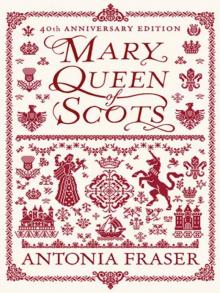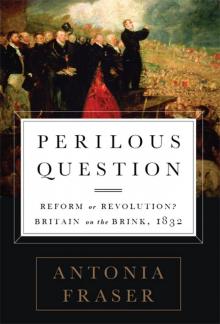- Home
- Antonia Fraser
The Warrior Queens Page 16
The Warrior Queens Read online
Page 16
But Zenobia did not fall. After a grim council of war, the decision was taken to abandon Emesa for the base stronghold of Palmyra, where at least the Palmyrenes would not have to contend with growing Syrian hostility. Zenobia’s withdrawal across the desert to Palmyra – a distance of perhaps one hundred miles – was something to which custom had habituated both her and her Arab troops. Aurelian’s pursuit, given the terrain and the ability of the nomads who inhabited it to harry him, was more of an ordeal and thus more of an achievement. And, once he had arrived to set up his blockade, Palmyra’s isolated position, with the caravans no longer active, told against her rather than her enemies. In the subsequent siege, it was famine as much as anything else which ravaged the inhabitants.
Zenobia however had not lost her spirit. It was at this point that her chronicler has her engaging in a correspondence with Aurelian on the subject of surrender.26 Aurelian was already publicly bemoaning his fate in being matched against a woman in that passage quoted earlier: ‘as if Zenobia was contending against me with her own strength alone …’ To the Queen herself he wrote in contemptuous terms: ‘And you, O Zenobia, may pass your life in some spot where I shall place you in pursuance of the distinguished sentence of the Senate; your gems, your silver, gold, silk, horses, camels, being given up to the Roman treasury.’
‘Thou askest me to surrender’, replied the Palmyrene Queen proudly, ‘as if thou wert ignorant that Queen Cleopatra chose rather to perish than to survive her dignity.’ In answer to Aurelian’s indignant question: ‘How, O Zenobia, hast thou dared to insult Roman emperors?’ she answered: ‘Thee I acknowledge to be Emperor, since thou has conquered’, but the rest of them, including Gallienus, she did not consider worthy of the name of chief – princeps. She added: ‘Believing Vitruviaf1 to be a woman like me, I desired to become a partner in the royal power, should the supply of lands permit.’
At the same time as firing off this defiant letter – about the authorship of which there would later be some significant dispute – Zenobia sought assistance from the Persians. It is kindest and by no means unreasonable to regard Zenobia’s subsequent secret flight from Palmyra as part of her plan for securing this Persian help, since Aurelian blocked off not only supplies but also any overt Persian relief force. Taking a female camel – ‘which is the swiftest of that kind of animal, and much more swift than horses’ – she managed to slip out of the beleaguered city. Riding furiously, Zenobia got as far as the Euphrates. Here she was captured as she was boarding a boat, either recognized or betrayed. Taken to Emesa, Zenobia found herself once more facing the Emperor Aurelian, but this time unaided by Palmyrene archers or cavalry.
Palmyra itself was captured and sacked. But in the persons of Aurelian and Zenobia an interesting battle of the sexes was joined, one from which the Palmyrene Queen undoubtedly emerged victorious. Aurelian for his part remained uneasy at his triumph over a mere woman, and reflected that in ages to come it might not redound entirely to his credit to have done so. He therefore continued to stress at length the amazing qualities of the Palmyrene Queen: a woman perhaps, but what a woman! So brave, bold, daring, prudent in council, firm in purpose, etc., etc. Moreover Odainat’s victories in Persia were due entirely to her, ‘such was the dread entertained of this woman, among the natives of the East and of Egypt, that she kept in check the Arabians, the Saracens and the Armenians’.28 Frantically Aurelian attempted to elude the taint of the Shame Syndrome, generally supplied to those who were actually defeated by ‘mere women’ like Boudica, but still capable of adhering to those who defeated them.
Zenobia on the other hand, displayed an impudence which should make her the admiration of any strong-minded woman finding herself in a tight corner in a masculine-oriented society. She simply turned round and claimed immunity on the grounds of her sex. In short, she ‘produced many persons, who had seduced her as a simple woman’. Even her bold letter of defiance to Aurelian was now ascribed to the scholar Longinus, although another scholar Nicomachus asserted to the contrary that Zenobia had dictated the letter to him personally, in order that he should translate it into Greek (which she could speak but not write).29 As a result, Longinus was executed. Zenobia however survived, as presumably had been her intention: for nothing more was heard after this of her bold desire to ‘perish rather than lose her dignity’.
All the evidence points to the fact that Zenobia was now taken captive to Rome. Zosimus is the only dissenting voice, but then in suggesting that Zenobia died on her way to Europe by her own hand he was manifestly trying to emphasize the identity of Zenobia with Cleopatra. Other versions agree with a wealth of circumstantial detail that Zenobia reached Italy in safety where she was obliged to walk in the Emperor’s triumph.30
One would like to have witnessed this apotheosis of the Emperor Aurelian, although preferably not in chains. First came a parade of the most curious wild beasts, including not only elephants but tigers, giraffes and elks: subsequently the prudent Aurelian gave this menagerie to various Roman citizens so that the privy purse would not be burdened with their upkeep. Then came the gladiators and then the ambassadors of such diverse empires as Ethiopia, Persia, India and China. The human menagerie which followed was of no less interest to the inquisitive spectators: captives from, as it seemed, every corner of the globe attesting to the range of Aurelian’s victories, and all neatly labelled with placards round their necks to din in the geography lesson (as diplomats today are labelled at a United Nations session). In this manner there trailed past not only the recent victims of the East, but also Hibernians, Vandals, Franks and Swabians. Among these last were a group of Gothic women who had been discovered fighting in men’s clothes: helpfully the placards around their necks read ‘Amazon’.
Four chariots in all formed part of the procession. One of these, which had once belonged to the King of the Goths, was drawn by stags: at the Capitol the stags would be slain and vowed to the altar of Jupiter. The others were of Eastern provenance: the chariot of Odainat, adorned with silver and gold, the chariot given to Aurelian by the Emperor of Persia, and the chariot of Zenobia (that chariot in which she had often disdained to ride, preferring with her ‘masculine energy’ the hardihood of horseback).
It was indeed Zenobia herself, walking in front of her chariot, who was the focus of every eye. She bore no placard round her neck, nor was she labelled ‘Amazon’ or for that matter ‘Penthesilea’ or ‘Hippolyta’. Nevertheless the half-fainting Palmyrene Queen (for once she might have been glad of that chariot), shackled by golden fetters and weighed down by the very mass of those jewels she had once displayed so proudly, stood by her very presence for Aurelian’s victory in the East, much as the Greek heroes’ legendary victories over the Amazons had symbolized the victory of Greeks over the barbarians.
Zenobia, the great survivor, survived the ordeal of the Triumph. She did more than that: she built a new life.31 At some later point, she seems to have married a Roman senator. At any rate she was able to retire in affluence to a villa, granted to her by the Roman state, at Tibur (Tivoli), near that of Hadrian. A hundred years later her descendants, either by this second husband or by Odainat – Vaballathus disappears from view, but two other sons walked with her in the Triumph – were known in senatorial circles; the fifth-century Bishop of Florence, Zenobius, may have owed his unusual name to a still remembered ancestress.
Zenobia’s instinct for survival, unlike her forcible marital chastity, has received a bad press from historians, although one can detect a certain gloomy satisfaction at finding a woman, however bold on the field, choosing to behave really badly in a genuine crisis. Theodor Mommsen thundered: ‘Zenobia, after she had for years born rule with masculine energy, did not now disdain to invoke a woman’s privileges and to throw the responsibility on her advisers.’ Gibbon was more philosophical: ‘as female fortitude is commonly artificial, so it is seldom steady or consistent’.32 For tradition has it that Zenobia, unruffled by such considerations, had the bad taste to enjoy her life as a
Roman matron. She held a fashionable salon in her villa, where only her outlandish Roman accent (but then she did speak Greek, Aramaic and Egyptian) betrayed her exotic origins. As Zenobia dispensed hospitality and perhaps told stories of her tribulations walking in the Triumph or even tales of desert rides – did she ever dream of that female camel, the swiftest in the business? – Aurelian was obliged to return to Palmyra. There he quelled another insurrection. Finally both Palmyra and Alexandria were plundered to excess and the Palmyrene civilization passed away.
So finally the story of Zenobia and the Romans, as a coda to that of Boudica, reminds one that there could be advantages in being a Warrior Queen – as opposed to a Warrior King – as well as disadvantages; or at least so far as the queen herself was concerned. Boudica was scourged (and her daughters raped), which it has been suggested was a deliberate outrage on the part of the Romans, connected to Boudica’s sex; Zenobia on the other hand betrayed Longinus with impunity, if one leaves out of account her short bejewelled travail on foot. The Only-a-Weak-Woman Syndrome – ‘I am as good as (or even better than) a man when I ride to victory but I’m Only-a-Weak-Woman when I’m defeated’ – is also part of the history of the Warrior Queen.
None of this should detract from the achievements of Zenobia in her prime. There is a figure of Arab legend called variously Zebbâ, al-Zabbà or az-Zabbà: a beautiful warrior who leads her troops to victory in a series of confrontations, as well as indulging in some wily tricks, based on her own charms.33 Zebbâ has two fortresses on the left and right banks of the Euphrates – in some stories her sister called Zainab (the Arab version of Zenobia) occupies one of them – and in one legend at least remains chaste; moreover Zebbâ, like Zenobia, is captured in an incident at a river. Although an exact connection between Zenobia and Zebbâ cannot be made – just as a historical figure like Boudica can never be exactly connected with the legendary Boadicea – nevertheless there are too many coincidences between them to dismiss it altogether.
It therefore seems fitting, as we go forward on the long march of Boudica’s mythical history, to remember that Zenobia also has her own lively myths in her own Arab culture (Zainab is a popular name in Syria today). A modern play by Assi and Mansour Al-Rahbani ends with Zenobia poisoning herself just before the Roman soldiers bind her in chains. She dies with the words ‘O Liberty!’ on her lips, and her mourning people promise themselves never to forget her (or the idea of liberty).34
It is good to bear this Arab heroine in mind; for we shall find the ‘chaste’ Zenobia appearing from time to time in a somewhat pallid disguise in Europe:
That lovely form enshrines the gentlest virtues
Softest compassion, unaffected wisdom,
To outward beauty lending higher charms35
as an eighteenth-century play had it. It is difficult to imagine this ‘beauteous mourner’ raising her ‘suppliant voice’ for ‘mild humanity’ carving out an empire from Egypt to Asia Minor in defiance of Rome itself. ‘O Zenobia, hast thou dared to insult Roman emperors?’ wrote Aurelian to the real-life Queen: she had and she did. It is Zenobia’s courage which links her to Boudica; her ambition (and her instinct for survival) sets her apart.
1 Victoria or Vitruvia, the influential mother of the rebel Gallic Emperor Victorinus (who succeeded Postumus in 268/9); she also helped the next Gallic Emperor, Tetricus, to power.27
Part Two
CHAPTER NINE
Matilda, Daughter of Peter
The daughter of Peter and the faithful hand-maid of Christ.
POPE GREGORY VII, to Matilda Countess of Tuscany
‘To you, my most beloved and loving daughter, I do not hesitate to disclose any of these thoughts, for even you yourself can hardly imagine how greatly I may count upon your zeal and discretion.’ The writer of this letter in late 1074 was Pope Gregory VII. The ‘most beloved and loving’ daughter in question was Matilda Countess of Tuscany, a woman now in her late thirties, who had inherited vast dominions in northern Italy from her father some twenty years back. As she moved towards independence from the various tutelages of mother and stepfather, increasingly she was acting as the ‘faithful hand-maid’ of St Peter – a hand-maid with a sharp sword in her hand and an army at her back.1
The combination of Countess Matilda’s prolonged military endeavours with her own sense of a holy mission is what made her egregious among her contemporaries: ‘For St Peter and Matilda!’ her men shouted as they stormed the fortresses of the Apennines while she termed herself ‘Matilda by the Grace of God’. It also inspired their admiration – if they were on the same side.
The approval which Matilda received from her allies and subordinates, based on her gender, not despite it, clearly related to the apparently ‘holy’ nature of her chosen role. The pious Christian Matilda would not have relished a comparison to pagan Boadicea, with her invocation to Andraste on the eve of battle a thousand years earlier. As a matter of interest, she would not even have recognized the allusion. Penthesilea was not forgotten and Matilda would receive the usual ration of such comparisons to the Amazonian Queen. However, not only had Boadicea vanished into her unknown grave but her very name had been forgotten, awaiting the rediscovery of Tacitus’ manuscripts in a monastery library in the fourteenth century.2 Yet Matilda’s role represents an important aspect of the subject of the Warrior Queen, that of Holy (Armed) Figurehead. Just as Boadicea must have gained strength from the image of the Celtic goddess in her people’s minds, so Matilda received practical support from the notion of the halo round her head – and the sword in her hand.
Not surprisingly, it was just this shining white garment of virtue which Matilda’s (political) enemies sought to defile. Calumnies included the suggestion of a carnal relationship with the Pope, and the suggestion that the ‘chaste’ Matilda actually had one of her husbands killed, and possibly her children as well. This was a deliberate attempt to counteract the undoubted propaganda value – to the papal side – of the image of Countess Matilda, both pure and powerful, encouraging her troops to the rescue of the Holy Father. The scandals as well as the paeans of praise bear witness to the successful possibilities inherent in the idea of the Armed (Female) Saint.
The Pope, assisted by his loving daughter, was involved for most of the years of his reign in an incessant power struggle with the German Emperor Henry V. From the point of view of Countess Matilda, it was an armed struggle which over thirty years would have enabled her to have claimed, with Schiller’s Wallenstein, ‘our life was but a battle and a march’. So in a sense the Countess Matilda did lay down her life for the papal cause – the cause of Christ, as she firmly believed.
The life she dedicated to the cause was that of a wealthy, high-minded and extremely religious aristocratic woman, who might otherwise have ruled her dominions and endowed her pious foundations with the suitable expectation of peace in this life and further peace to come ‘in the heavenly country’. This was the life she finally led as a very old lady, when these papal–imperial troubles were in any case subsiding, helmet and mail finally, as it were, put away. Yet as the devout and filial language of the ‘hand-maid’ Matilda towards the Pope indicates, fully reciprocating his own intimacy, the sacrifice, if sacrifice it was, was one that she herself felt called by God to make. At one point she borrowed the words of the Apostle to say that neither tribulations nor anguish, nor hunger, nor peril, nor persecution, nor swords, nor death, nor life, nor angels, nor principalities, nor virtues, nor the present could ever separate her from the love of Peter.3
Matilda of Tuscany – Matilda of Canossa as she is sometimes known – was born in about 1046 somewhere in northern Italy.4 Her father was the Margrave Boniface II, head of a family based on the mighty Apennine fortress of Canossa, and invested with the office of Margrave by the Roman Emperor-cum-German King, Conrad II, in 1027. Boniface’s lands stretched roughly speaking from the Apennines to the Alps, sweeping across the wide plain of Lombardy; but he held many of them in feudal tenure to Conrad II since in a
revival of the idea of the ‘Roman Empire’ of Charlemagne, the elected German King was in his capacity of ‘Roman Emperor’ currently exercising lordship over northern Italy.
Charlemagne’s ‘Roman Empire’ had been conferred on him in 800 by the Pope and brought back for the German kings in the middle of the tenth century. Officially, therefore, Conrad, like other German kings of this period, owed his position in Germany to election by the German princes; while he had to be crowned by the Pope as Roman Emperor. That at any rate was the theory of the thing.
Matilda’s mother was Boniface’s second wife Beatrice, daughter of the Duke of Upper Lorraine. Hereditarily speaking, Matilda must have owed at least as much to her clever, capable mother as to her rough warlord of a father; while in terms of environment Beatrice’s influence must certainly have been paramount since the Margrave Boniface was killed when Matilda was six.
It was to be a turbulent childhood, a presage of Matilda’s adult life. The death of her father and the deaths of her brothers – their precise number is in question but the relevant point to Matilda’s story is that they did not survive – left Matilda theoretical heiress of Boniface’s extensive lands. But the rules of inheritance, given the vital imperial exercise of Italian overlordship, were not at this date quite so simple. The Emperor Henry III, for example, who had succeeded Conrad II in 1039, claimed the right to invest a male child with those of Boniface’s Tuscan territories which he had held in feudal tenure, although this still left Matilda as heiress to the Canossa family heartlands. Moreover Henry III was in an increasingly strong position to enforce his wishes since the fortunes of the German-ruled ‘Roman Empire’ were waxing. Burgundy had fallen to Conrad II by inheritance; Henry III himself had extended his sway over Bohemia, Bavaria and Hungary, as well as over the Normans in the south of Italy.

 Warrior Queens
Warrior Queens The Gunpowder Plot
The Gunpowder Plot Cromwell
Cromwell The Weaker Vessel: Women's Lot in Seventeenth-Century England
The Weaker Vessel: Women's Lot in Seventeenth-Century England Marie Antoinette: The Journey
Marie Antoinette: The Journey Oxford Blood
Oxford Blood Your Royal Hostage
Your Royal Hostage Cool Repentance
Cool Repentance Mary Queen of Scots
Mary Queen of Scots Political Death
Political Death Royal Charles: Charles II and the Restoration
Royal Charles: Charles II and the Restoration My History: A Memoir of Growing Up
My History: A Memoir of Growing Up Perilous Question: Reform or Revolution? Britain on the Brink, 1832
Perilous Question: Reform or Revolution? Britain on the Brink, 1832 Jemima Shore at the Sunny Grave
Jemima Shore at the Sunny Grave A Splash of Red
A Splash of Red Must You Go?: My Life With Harold Pinter
Must You Go?: My Life With Harold Pinter Love and Louis XIV: The Women in the Life of the Sun King
Love and Louis XIV: The Women in the Life of the Sun King The Warrior Queens
The Warrior Queens The Wild Island
The Wild Island Quiet as a Nun
Quiet as a Nun Perilous Question
Perilous Question Cromwell, the Lord Protector
Cromwell, the Lord Protector Gunpowder Plots
Gunpowder Plots The Wild Island - Jemima Shore 02
The Wild Island - Jemima Shore 02 Gunpowder Plots: A Celebration of 400 Years of Bonfire Night
Gunpowder Plots: A Celebration of 400 Years of Bonfire Night Gunpowder Plots_A Celebration of 400 Years of Bonfire Night
Gunpowder Plots_A Celebration of 400 Years of Bonfire Night Marie Antoinette
Marie Antoinette Must You Go?
Must You Go? My History
My History